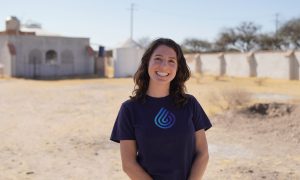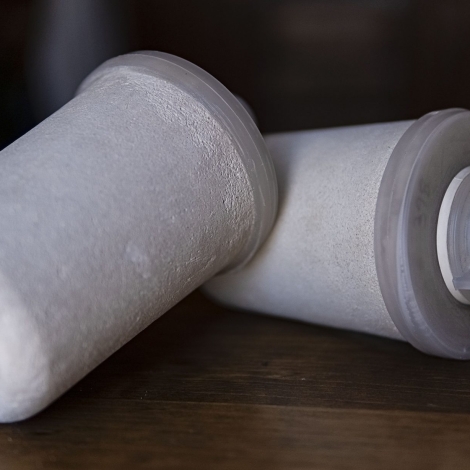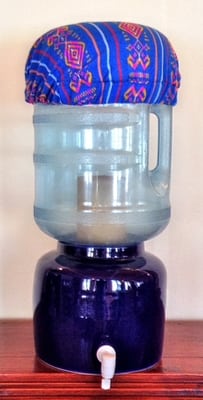 A well designed water treatment system should be easy to forget. If the design merges science and simplicity, people can drink clean, safe water without the need to learn complicated operating instructions or change their usual habits. Allie Reiling and Dylan Terrell at Caminos de Agua led the research and development of a ceramic filter that seems to meet both criteria. In tests, the Aguadapt filters nearly all pathogens and many of the chemical contaminants found in untreated water. The device also fits in lots of different water receptacles, so people can use it with the bottles, jugs and usual tools they are comfortable using when they drink water. People have noticed, and the filter has won awards, including the US arm of ASME ISHOW 2019, the Innovation Showcase by the American Society of Mechanical Engineers (ASME is Engineering for Change’s parent organization).
A well designed water treatment system should be easy to forget. If the design merges science and simplicity, people can drink clean, safe water without the need to learn complicated operating instructions or change their usual habits. Allie Reiling and Dylan Terrell at Caminos de Agua led the research and development of a ceramic filter that seems to meet both criteria. In tests, the Aguadapt filters nearly all pathogens and many of the chemical contaminants found in untreated water. The device also fits in lots of different water receptacles, so people can use it with the bottles, jugs and usual tools they are comfortable using when they drink water. People have noticed, and the filter has won awards, including the US arm of ASME ISHOW 2019, the Innovation Showcase by the American Society of Mechanical Engineers (ASME is Engineering for Change’s parent organization).
Caminos de Agua concentrates its work in central Mexico, with programs in other parts of the world. The organizations develops and distributes Aguadapt and other water access technologies, such as rainwater harvesting and water quality monitoring systems, among vulnerable communities and people who earn less than (USD) $2 per day.
In a collaboration with the Lemelson Foundation, one of the sponsors of ISHOW, we’re taking a new look at ISHOW winners to learn about their innovations and their progress to date. Allie Reiling is a water engineer and Director of Technology at Caminos de Agua, and Dylan Terrell is Founder and Executive Director of the organization. We asked them five questions, and they worked together on the responses.
E4C: How would you describe the progress you’ve made with Aguadapt since ISHOW?
AR&DT: The support we received from the ASME ISHOW has been integral in continuing our progress of the design and production of Aguadapt. Since ISHOW, we have completely revamped our ceramic manufacturing technique and invested in long-term molds with our new plastics manufacturer. This has implied targeted design revisions, many prototypes, and continuous testing. At the ISHOW event and with our connections made there, we were able to get advice and technical expertise that guided our progress. In late 2019, we began investing in the commercialization side of Aguadapt; however, when the COVID 19 pandemic struck, we had to refocus our commitment on our community projects, specifically working directly with those most at risk due to limited water supplies. Consequently, we had to put commercialization on hold, but are hoping to revamp the efforts again soon.
Although we are not widely distributing and selling the Aguadapt at the moment, we are so proud of the overhaul we have been able to make, resulting in a more robust and consistent product. Next steps include further QC testing and development of the subsequent treatment cartridges, alongside the development of the production and sales branches as we begin to refocus our efforts on larger-scale commercialization.
Our plans include scaling up production and expanding our customer base. In order to get there, we need to move from the phase of testing our updated Aguadapt design in order to get to a point where we feel comfortable resuming distribution. Even passively, we have a pretty significant demand for this filter. However, it’s paramount for us to be comfortable with our internal objectives before we can distribute the solution to a wider audience.
E4C: How do you make sure the water filters work?
AR&DT: Aguadapt is based upon a ceramic filter treatment element. These ceramic filters have undergone certification by the Mexican Commission for the prevention of Sanitary Risks (COFEPRIS) and have also been tested and verified by both the State Water Commission of Queretaro (CEAQ) and the National Water Commission (CONAGUA). We have also done extensive testing with university partners such as University College of London. In addition, we currently do rigorous in-house testing to make sure that the filters are removing bacteria and pathogens using aggressive indicators, such as e.coli, to assure the efficacy of the filter. Given our open-source philosophy, all of our data and studies are available for review upon request.
E4C: There are a lot of water purification technologies available. What makes Aguadapt different?
AR&DT: Yes, the market for low-cost filters is saturated. Hundreds of models from manufacturers can remove sediment and biological pathogens, however none of these low-cost filters remove emerging chemical contaminants. In central Mexico we see more and more contamination of arsenic and fluoride, in many parts of the world contaminants such as agrochemicals (among others) are entering water supplies, disproportionately affecting low-income communities. Traditional low-cost water filters are simply not equipped to deal with this new class of water contamination. These chemicals are completely dissolved and require targeted solutions that most, if not all, existing low-cost water filters simply cannot address. To ensure that everyone has access to water that is fit to drink in the 21st century, we need to start taking into account this new class of chemical contamination that is closely linked to a myriad of chronic health conditions including learning and cognitive development disabilities in children and even multiple cancers.
Additionally, most water filters are designed with proprietary components, which means that if something breaks, finding replacement parts can be a challenge and expensive. Aguadapt uses a universal threading design, meaning that standard plumbing parts found at even small hardware stores around the world can be used and adapted. This turns Aguadapt into a “treatment platform” where other researchers and organizations around the globe can design and adapt additional treatment steps based on their locally-relevant water quality challenges.
There comes in the unique power of the Aguadapt treatment platform. Ideal for both long-term use as well as emergency response, Aguadapt lasts for over four years, removes sediment, up to 99.9999% of all pathogens, is quickly installed in any container, and can also be easily adapted to treat emerging chemical contaminants like fluoride, arsenic, agrochemicals, and many others. The beauty of Aguadapt is that it can adapt to local contexts, removing only the necessary, locally-relevant contaminants without the cost of having to remove all of the contaminants. A low-cost treatment system, Aguadapt is primed to advance the future of water filters and help NGOs, social enterprises, and governments secure dignified drinking water for their audiences, customers, and citizens.=
E4C: Other product designers could learn from your experience. Would you share some lessons learned?
AR&DT: Sharing experiences and learning from each other is so crucial. Here are two of the main lessons we have learned over the years.
First, spend time getting to know and listening to users. This will help guide you towards a solution that is actually useful and ‘real-world’ applicable. You have a lot to learn from getting to know the lives of your users and hearing their feedback, but this requires much more time investment than a couple of short field trips. To do this right, it really can’t be understated the importance of actually living in the region you are trying to impact and using the innovations you’re designing in your own daily life. So much design and innovation is disconnected from the reality of real users. Spend some time living where you hope to make an impact and using the design innovations yourself in your daily life, even with your own family and children. Having “skin in the game” makes you so much more likely to make an appropriate and effective solution.
Two, don’t be afraid to make adjustments and change your path when something isn’t working. Keeping this flexibility will help you continue to evolve toward success.
E4C: How do you measure impact and what impact has your product had so far?
AR&DT: Our impact is measured through monitoring and evaluation (M&E) of our systems in the field. We do this by revisiting installed filters and addressing questions related to the developed indicators. We’ve developed an extensive M&E program that measures dozens of indicators across 8 specific areas. As for environmental impact, we focus on being as local as possible. Our entire team lives and works in our base of operations in Central Mexico. Despite being a US-registered 501(c)(3) nonprofit organization, we have no staff in the US as that is not our target market. We use local materials such as clay, available 20 minutes away in one of the largest ceramic-producing regions in the country, and sawdust that is a byproduct from a semi-local lumber operation. Other technologies related to Aguadapt, such as the biochar and bone-char water filtration media we produce here locally, which remove organic chemicals and fluoride respectively, are both actually carbon negative technologies. To top it off, Aguadapt does not need to be connected to a power source and does not use electricity, as it is gravity driven.
[In the future] the Aguadapt system will have a huge impact in communities and with individuals, especially those living on less than (USD) $2 per day, introducing the power of adaptability in order to create appropriate modern water treatment solutions.

